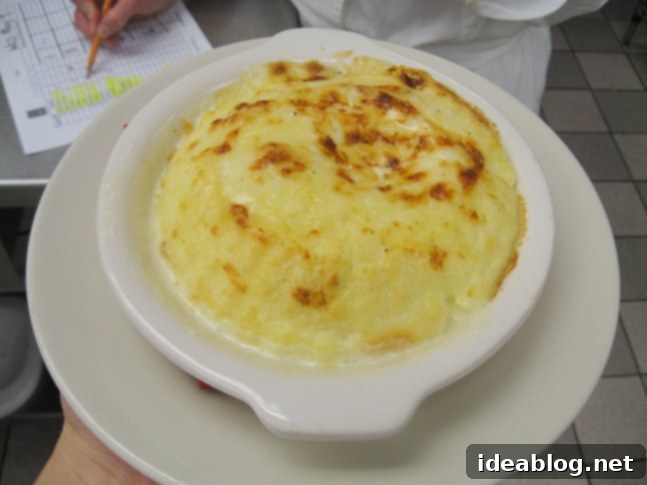A Week of Culinary Mastery: From Twice-Baked Soufflé to Artisanal Baklava and Wine Appreciation
This past week marked another engaging chapter in our culinary school journey, balancing intense learning with the sheer joy of creating diverse dishes. Wednesday, in particular, was a highlight, packed with a fascinating range of production tasks that challenged our skills and expanded our palates. We delved into the delicate world of French cuisine, explored a unique interpretation of Indian flavors, and perfected a beloved Middle Eastern dessert, all while deepening our understanding of culinary techniques.
We kicked off the day by mastering yet another variation of the classic soufflé, this time a luxurious twice-baked cheese soufflé. This sophisticated preparation involved a multi-stage process that truly highlighted the versatility of the soufflé base. First, we carefully prepared the soufflé batter, rich with cheese, and poured it into individual spring-form tart shells. These were then baked until they achieved their signature impressive puff, a moment of triumph for any aspiring chef. The anticipation as they rose in the oven was palpable, each golden dome a testament to precise technique and timing.
Once perfectly puffed and golden, we gently inverted these delicate creations into elegant gratin dishes. The next step was perhaps the most indulgent: generously pouring a reduced cream sauce over each soufflé. This added a layer of incredible richness and moisture, transforming the light soufflé into a more substantial and deeply flavored dish. They were then returned to the oven for a second bake, this time to brown the top and allow the cream to meld perfectly with the cheese. While undeniably a sophisticated and interesting technique to learn, the sheer richness was almost overwhelming for my personal taste. Nevertheless, it was an invaluable lesson in classical French cookery, showcasing a method I had never encountered before and expanding my repertoire significantly.
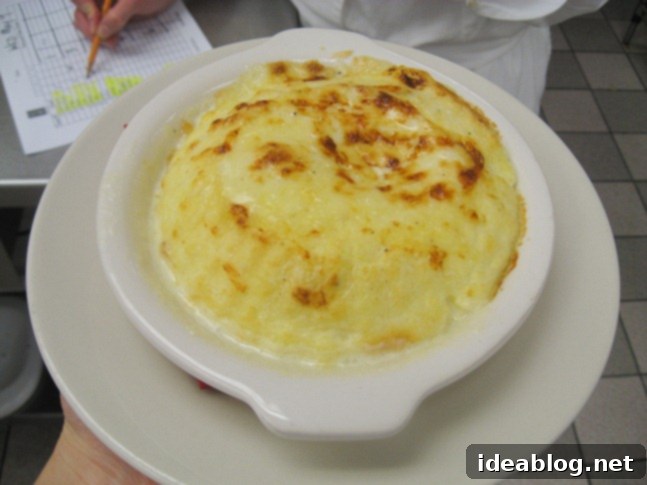
For our main course, we embarked on a culinary exploration with an “Indian” chicken curry. I use quotes around “Indian” because this particular rendition was a fascinating French interpretation of the traditional dish, offering a unique blend of flavors and techniques. The ingredient list itself hinted at its distinctive character, featuring unexpected elements like ground green apples, a banana (which initially gave me pause), celery, onion, and tomato. This unconventional combination promised a flavor profile far removed from what one might typically expect from an Indian curry, leaning instead into a more aromatic and subtly sweet complexity.
The preparation began with the chicken pieces, which we first floured and seasoned with a touch of curry powder to enhance their flavor and ensure a beautiful sear. After searing them to a golden brown, the chicken was then introduced to the sauce, where it slowly braised. This low-and-slow cooking method was designed to tenderize the chicken to perfection, allowing it to absorb all the intricate flavors of the sauce over time. The braising process is crucial for developing depth and richness, ensuring every bite is succulent and flavorful.
To achieve the desired consistency, we used almond meal as a thickening agent at the end – a technique that was quite unusual but effective. Initially, I was skeptical about how these diverse ingredients would harmonize, particularly the banana and almond meal. However, I was pleasantly surprised by the outcome. The curry was quite good, boasting a complex sweetness and a satisfying texture. My only personal critique was that it definitely needed more heat to truly awaken the palate, at least in my opinion. It was served simply over a fluffy basmati rice pilaf, which provided a perfect canvas for the curry’s unique flavors and added a comforting, aromatic touch. This dish was a testament to how different culinary traditions can merge to create something new and exciting.
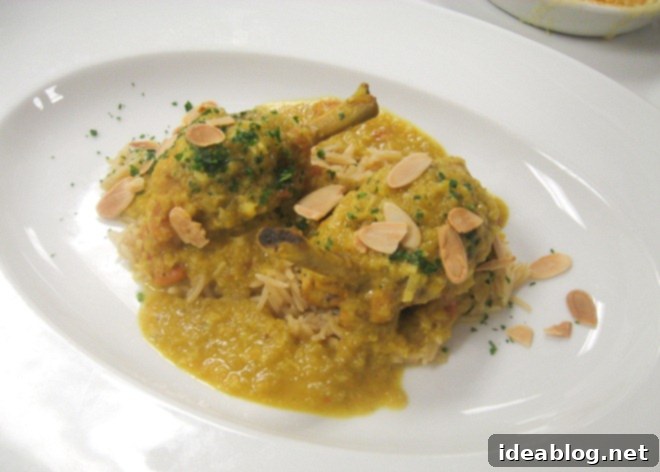
Dessert brought us to the rich, layered world of baklava, a timeless Turkish delicacy. This was a personal favorite, and I was incredibly excited to learn how to prepare it from scratch. Our version featured a generous blend of ground nuts – pistachios and walnuts – nestled between countless delicate layers of phyllo dough. The final touch, a simple syrup, was elevated with a fragrant infusion of lemon and orange zest, the alluring aroma of orange blossom water (a true delight!), and warming cardamom pods, creating a symphony of sweet and spicy notes.
Working with phyllo dough, while known for its delicate and sometimes challenging nature, proved to be a surprisingly manageable and rewarding experience. While it certainly demands patience and a gentle hand, the process of assembling the baklava was relatively straightforward, though a bit time-consuming. The secret to achieving its characteristic crispness and rich flavor lies in the liberal use of clarified butter. Each individual sheet of phyllo, and there were many, was meticulously brushed with this golden liquid before being layered, ensuring a flaky texture with every bite.
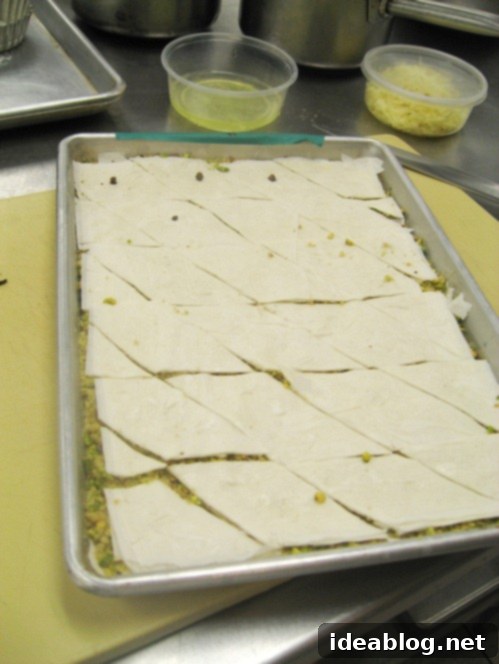
The construction of our baklava was a meticulous process designed to create distinct layers of pastry and nut filling. It began with laying down six sheets of phyllo, each brushed individually with clarified butter, building a sturdy base. This was then topped with a generous layer of our aromatic ground nut mixture, which we had seasoned with cinnamon, ground clove, cardamom, and other warming spices, adding depth and complexity to every morsel. Another six sheets of butter-brushed phyllo followed, creating a divider, then a second layer of the spiced nuts, and finally, a last layer of phyllo dough to encase the entire creation. The assembled baklava was then refrigerated to firm up slightly, making it easier to slice into its traditional diamond shapes. To ensure the layers remained intact during baking, we ingeniously pierced each piece with a whole clove, which was later removed, acting as a natural pin. The tray then went into the oven for approximately 30 minutes, baking until golden brown and gloriously fragrant.
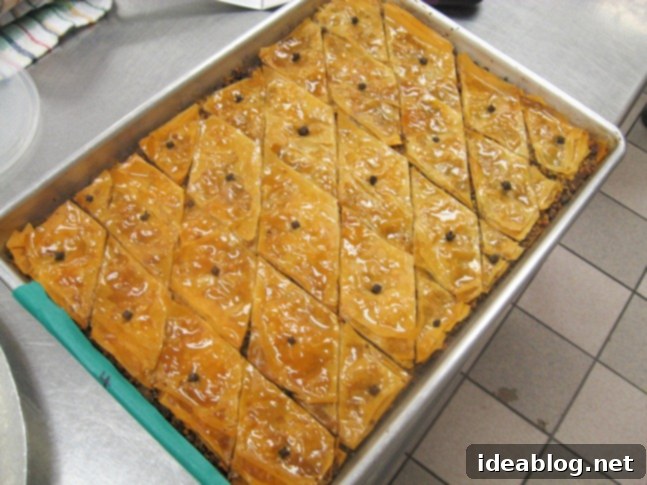
The final, crucial step in baklava making is the application of the simple syrup. As soon as the baklava emerged from the oven, still sizzling hot, we poured the aromatic hot syrup evenly over the entire surface. This allows the hot pastry to absorb the sweet, fragrant liquid, transforming it into the glistening, sticky, and utterly delicious dessert we all know and love. Ideally, baklava should sit for several days in the fridge to allow the flavors to fully meld and the syrup to properly soak in, resulting in a perfectly firm yet moist texture. While we only had about an hour for ours to sit due to production schedules, it was still incredibly good! A longer resting period would undoubtedly have made it even firmer and more deeply saturated with flavor. Reflecting on the process, I believe an additional couple of layers of phyllo and nuts might have elevated it further, adding even more textural contrast and richness.
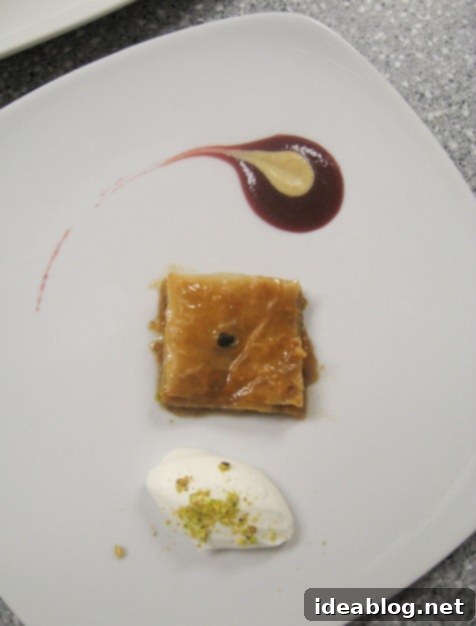
Overall, it was a relatively laid-back week at school compared to the high-stakes intensity of the previous week’s Restaurant Challenge. This gentler pace provided a welcome respite before the impending exam week, allowing us to focus on technique and flavor without the pressure of a full service. Once our production tasks were complete, we moved on to our second wine lecture. This session was an insightful exploration into the world of viticulture, where we had the opportunity to taste three more red and white wines. The discussion centered around the fascinating differences between “Old World” (European) and “New World” (essentially any non-European) wines, covering their distinct characteristics, production philosophies, and regional influences. These lectures are invaluable, offering a deeper appreciation for the beverages that so often accompany fine cuisine.
The culinary adventures continued the next day with a special field trip. We enjoyed a slightly later start than usual before heading off to Boxwood Winery. This promised to be an incredible hands-on experience, connecting our classroom discussions on wine with the real-world process of winemaking. I’m eager to share the insights and pictures from that visit soon, along with a short update on Friday’s exciting market basket challenge! These field trips truly bring our education to life, providing context and inspiration.
P.S. On a lighter note, make sure to check out the absolutely adorable ducklings that hatched recently right behind our school! Their playful antics added a charming touch to our daily routine and reminded us of the beauty of nature even amidst our bustling culinary environment.

